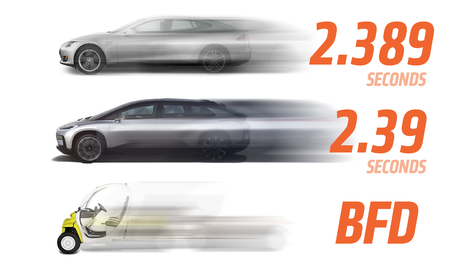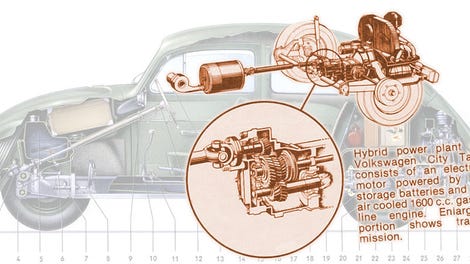
I have a friend who is unusually good at salvaging crap. Just this weekend he found, in an abandoned house, a perfect rear bumper (and brackets!) for my Beetle. That’s amazing enough, but he also found a set of NASA documents from the 1970s. Surprisingly, one of those volumes had, of all things, some fascinating information about a largely forgotten NASA electric car project. Reading about that car, it’s amazing how far the technology and the perception of electric cars has come.
Advertisement
The volume itself is a record of the 1979 NASA Authorization hearings before the Subcommittee on Space Science and Applications. Of course, it’s full of interesting stuff—this was the period where the Space Shuttle was being completed, and NASA was still hoping to get it flying in time to help save Skylab—but what really caught my eye was this little picture of a strange little car:
That little car is the Garret-Airesearch Electric Hybrid Vehicle. And, yes, the Garrett in question is the same one many of you gearheads will know as the turbocharger-making company. It seems that during this time, NASA was providing “total project management” for the Department of Energy’s Near-Term Electric Vehicle Development Program, and this Garrett-Airesearch car was one of the results.
Advertisement
There’s not a whole lot of information about this car online. At first I wasn’t even sure it existed beyond just some drawings, but I soon found out that an actual one was built, and it’s even weirder than I first suspected.
What’s interesting about the Garrett-Airesearch car is that it’s actually a hybrid vehicle, even though it’s a pure electric car. Based on what we all know about hybrid cars, that makes no sense: in hybrids as we understand them, even if only the electric motor powers the wheels, there’s still always some sort of combustion engine involved, like in a Prius or a Volt or a Karma or whatever.
The Garrett-Airesearch car, though, was a very different kind of hybrid: it was a flywheel-battery hybrid.
That means that there’s no combustion engine involved, just two separate ways to store energy: a set of lead-acid batteries, and a spinning flywheel mounted in a vacuum-holding housing. Flywheel-powered electric cars have existed before, like Chrysler’s aborted Patriot LeMans car, but as far as I know, this is the first time a flywheel has been paired with batteries to produce a general-use hybrid-electric car.
One of these was actually built, and was covered in 1980 in an issue of Popular Science.In that article, there’s some great images of the prototype itself, which stayed sort of close to those original drawings, but looks sort of like what a Tesla Model 3 would have looked like in an alternate, slightly dystopian 1980s.
The flywheel was housed horizontally under the floor in the rear, taking up about as much space as a spare tire, according to Popular Science. Essentially, the flywheel was needed because those 6 volt lead-acid batteries of the time—barely any different than golf-cart batteries—sucked so badly.
Advertisement
Sponsored
Getting an electric car up to highway speeds would just about kill batteries like that, and any spike in demand was considered “abusing” the battery. So, what the flywheel did was to act like a load-leveler for the battery. The flywheel could handle the spikes in electrical demand, and as a result the draw from the batteries would remain nice and steady, which is what those batteries liked best.
Even though the fundamental technology and design of electric cars really hasn’t changed much since this science project (electric motors mounted at the rear axle, lots of batteries in the tunnel and floor) it’s remarkable how far battery technology has come since the 1970s and 1980s, and how much our attitudes to electric cars have changed.
Advertisement
Consider these quotes from the article:
A “good chance at a multiyear life for the battery pack?” Holy crap, just think about that. For all the trepidation I may have about the longevity of the battery packs of a Tesla, we’re talking about something that should give close to a decade of service, not just hoping it lasts more than a single year.
Even more interesting is the way these cars were perceived back then, and the expectations that the developers thought the driving public would have. I want you first to think about the current insane obsession among electric car makers with having the best 0-60 time, and then read this:
Oh man, there’s so much here. First, the standard of unreasonable acceleration is set by the makers of the car at 10 seconds to get to 60 mph. Keep in mind that the recent horsepower wars equate to 0-60 times well under three seconds.
In the prototype stage, engineers are free to be as rational as they’d like and not even bother testing “jackrabbit” starts. Because they don’t have to sell any cars. If Tesla’s slogan was “No reasonable driving cycle requires you to go from zero to 60 in 10 seconds, only in a Tesla!” I guarantee you they’d have gone the way of the Corbin Sparrow and other pokey electric cars.
Advertisement
Advertisement
One small design note I’d like to point out about the Garrett-Airesearch concept drawing that was surprisingly forward-thinking: the marker light placement. Sure, it’s a tiny detail, but I think this is the earliest I’ve seen a car design that puts the marker light inboard and ahead of the headlight:
This same basic approach has become popular on modern cars, where the marker light is housed inside a larger headlamp unit. The look, of course, is different, but the concept is the same.
So, there you go: with the exception of marker lights, we’ve come a very, very long way with our electric car technology and attitudes since the 1970s and 1980s. Just in case you forgot.
I mean, I guess we’ve come that far with almost everything except our napkin-dispensing technology
















